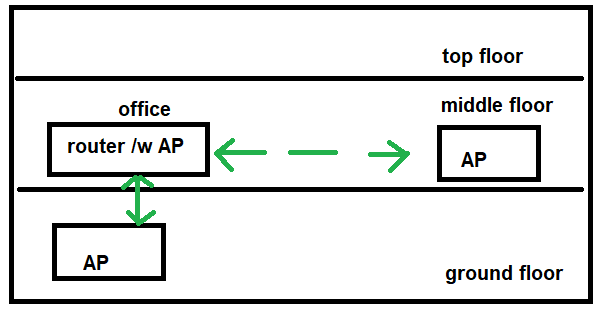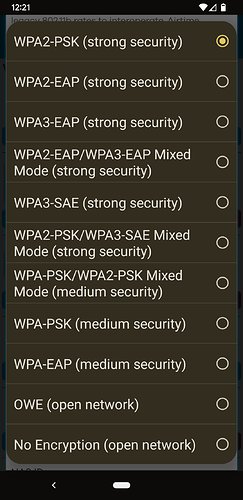You can read "mesh point", so it does. You need now to replace wpad-basic-wolfssl by wpad-wolfsll and than setup the mesh.
There is no need of mesh11sd for setting up a mesh. I have always done without it. Nevertheless it seems to offer advanced features according to its doc, you may have a look at it.
It's worth checking if you actually need mesh. Marketing hype has certainly made it sound cool. Are you e.g. running a fairground that expects moving stations that come and go?
Absent such peculiar implementations it seems WDS is the more appropriate choice for the typical setup with a couple of fixed access points.
You don't "need" mesh11sd but it can get very difficult without it if you have more than a couple of mesh nodes as it is not possible to set required parameters in the uci wireless config.
With mesh11sd everything required is set correctly and monitored to make sure it stays that way, supporting from just 2 nodes close to each other right through to large geographically spread mesh backhauls - all without having to mess with settings.
That is certainly true. Marketing by some companies, for products that use a proprietary non-mesh wifi "relay" or "extender" method, usually built into the hardware, has led to many misconceptions.
That is not the point of an 802.11s mesh. Rather the point is to enable a self configuring and resilient backhaul.
For two fixed access points even that is not true. WDS might give slightly better performance than 802.11s. The reason WDS seemed to be a better choice in the past was that configuring a mesh network was not easy and WDS configuration was well supported and understood. Technically, for two APs, there is little or no difference between using WDS or 802.11s, performance wise. More than two, then WDS gets more and more complicated and gets left behind by 802.11s mesh where every node can have identical configuration.
Which out of mesh and WDS would give the best performance in terms of throughput and latency for typical WiFi clients such as laptops, iPads and phones in this setup:

Router (itself also AP) in office situated in middle floor at end of house. There is an AP on floor below and an AP at other end of house on middle floor. The additional AP's are to wirelessly connect with the router.
Is it wrong to assume higher tx power would give better overall performance (mindful of throughput, latency and 802.11r)? I just set appropriate country code (GB) and use default power.
I would expect in this scenario that WDS would be better because it is "just" sending packets, whereas 802.11s is doing layer 2 mac-routing.
I have tried both WDS and 802.11s in similar scenarios and found in practice the difference was not noticeable from a general use point of view. Sure you could do detailed measurements to find the answer and if every scrap of performance mattered to you then WDS would be the winner.
But lets say you wanted 3 more APs, 2 on the top floor and 1 more on the ground floor, then 802.11s mesh becomes very attractive. (Imagine a hotel with multiple floors, long corridors, thick walls etc. combined with a physical difficulty of installing cables with the associated business impact of cabling and cabling costs compared with wandering around plugging in a set of identically configured meshnodes. )
Generally yes it is wrong to assume that.
Me too - usually - depends on the site.
For this you need non-overlapping channels on the APs. In this scenario, for both WDS or 802.11s, the APs would have to be dual radio.
Ah, but wait. I thought to use WDS or mesh the radios have to all be on the same channels?
You need for 802.11r I.e fast roaming, both 2.4Ghz and 5Ghz radio will be used. One acting as a mesh/WDS back haul and other will be used for fast roaming?
Yes exactly my point ![]()
If you want fast roaming then yes that is one way to do it. But then fast roaming can block clients that do not support it.....
So if needing to use WDS or mesh and setting radios to same channel and enabling FT is that bad?
I believe so, at least that is what I have read.
what is FT?
802.11r fast transition.
So I have main router offer WDS AP for guest Wi-Fi on 2.4 and offer separate WDS AP for main Wi-Fi on 5. This trick seemed to avoid a great deal of extra complication associated with offering out Wi-Fi for these isolated networks.
Namely the latter trick avoids this nightmare:
The extra RT3200's connect to the main router as WDS clients for both guest Wi-Fi on 2.4 and also the main Wi-Fi on 5 and then also offer out AP's for guest Wi-Fi and main Wi-Fi.
I believe for all of this to work the 2.4 and 5 radios on all 3x RT3200's have to be on same channel. I may be mistaken and if so I'd love to know in case I can improve my setup.
Note that 802.11r makes your WPA2 PSK network easier to hack [1] because of PMK caching.
[1] https://techbeacon.com/security/wpa2-hack-allows-wi-fi-password-crack-much-faster
which means Only SAE is the option in roaming?
Yikes. So what should we switch to if we want to keep the benefits of 802.11r roaming but avoid the security issue? The options I am offered via OpenErt are a bit mind boggling:
Can someone please recommend an option?
WPA3 and WPA2-EAP are both fine. I assume mesh as well. Only WPA2-EAP will give you wide compatibility though at the cost of harder to configure. I personally decided to live without fast transition as it is not really a big concern for my network.
Does anyone know the full wpad contains SAE for encrypted mesh?
wpad - 2020-06-08-5a8b3662-40 - This package contains a full featured IEEE 802.1x/WPA/EAP/RADIUS Authenticator and Supplicant
It is not obvious from description.
No. You need wpad-mesh-wolfssl as a minimum or wpad-wolfssl.
